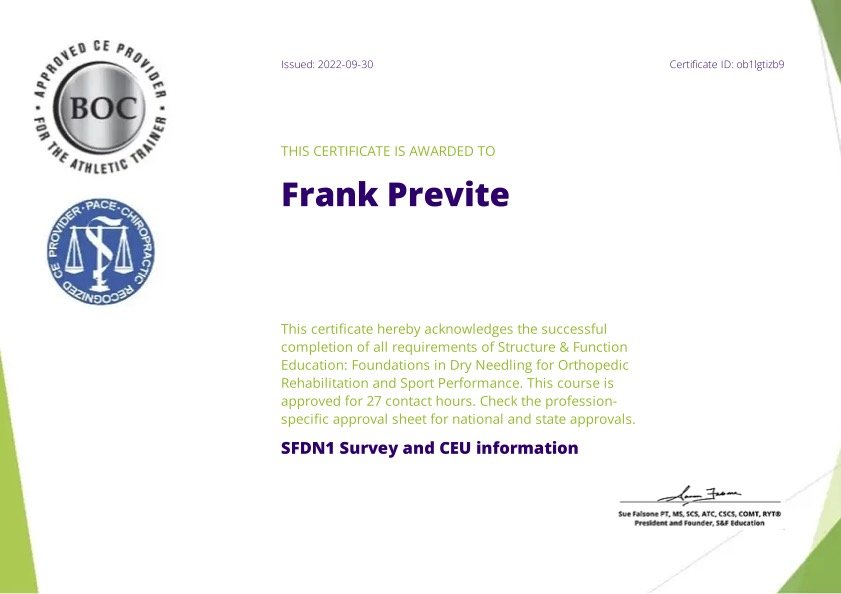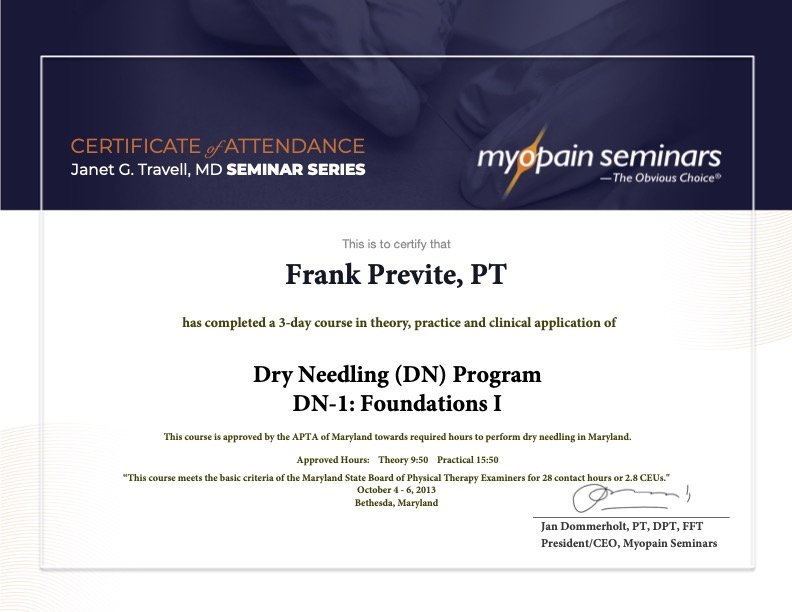
Dry Needling
We are proud and excited to announce that Governor Murphy signed S867 into law on January 18, 2022 which “permits physical therapists to perform Dry Needling under certain circumstances.”
Current law permits Physical Therapists (PT) to perform dry needling (37 states and DC), law prohibits (5 states CA, HI, NY, OR, WA), law is silent (8 states). The law went into effect April 18, 2022 in New Jersey.
See the Dry Needling FAQs below and my certificates documenting the extensive training and credentialing I’ve received in this safe, effective and innovative treatment technique. I look forward to setting up your first appointment with you! - Frank Previte, PT













DRY NEEDLING FAQs
What is dry needling?
Dry needling is an invasive procedure in which a thin solid filament needle is inserted into the skin and muscle directly at a muscle trigger point. A myofascial trigger point consists of multiple contraction knots, which are related to the production and maintenance of the pain cycle.
How does dry needling differ from acupuncture?
There are many similarities and differences between dry needling and acupuncture. Licensed physical therapists in a growing number of states can use dry needling under the scope of their practice. Spine & Orthopaedic PTs are not licensed acupuncturists and do not practice acupuncture. Dry Needing is strictly based on Western medicine principles and research.
What types of problems can be treated with dry needling?
Dry needling can be used for a variety of musculoskeletal and neurological problems. Such conditions include, but are not limited to neck, back and shoulder pain, arm pain (tennis/golfer’s elbow, carpal tunnel), migraines and tension type headaches, jaw pain, buttock and leg pain (sciatica, hamstring strains, calf tightness/spasms, heel pain). Muscles are thought to be the primary contributing factor to the symptoms. The treatment of muscles has the greatest effect on reducing pain mechanisms in the nervous system.
Is the procedure painful?
Most patients do not feel the insertion of the needle. The local twitch response elicits a brief (less than a second) response which some patients describe as a dull ache, cramping sensation or little electrical shock. The therapeutic response occurs with the local twitch responses and that is a good and desirable reaction.
Are the needles sterile?
Yes, we only use sterile disposable needles.
What side effects can I expect after treatment?
Some patients report being sore after the procedure and others report a gradual reduction of pain absent of discomfort. When soreness is described, it is local to the area of treatment and into the areas of referred pain lasting approximately a few hours and rarely more than a day.
Why is my doctor not familiar with dry needling?
In the US, dry needling is a relatively new method for treating myofascial pain and not everyone is aware of this effective modality. Feel free to inform your doctor about this new and innovative way to treat pain.
Once I am feeling better, how often do I have to come back to maintain my progress?
The musculoskeletal system is under constant pressure from gravity, stress, work, cumulative micro-trauma, poor posture, etc. A regular exercise program combined with good posture can prevent many problems. If the pain comes back, “tune-ups” are recommended to treat and prevent serious injuries.
